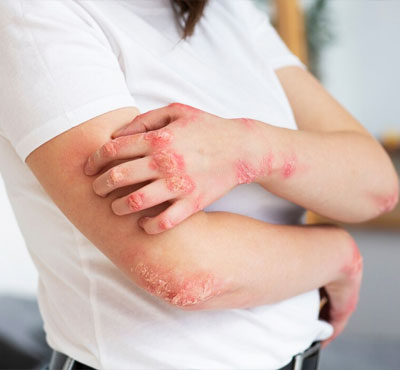What Is Psoriasis?
Psoriasis is an immune-mediated disorder in which the body's immune system accelerates the skin's cell life spans. Normally, skin cells are replaced within weeks, but in psoriasis, timescales can be reduced to days. The rapid turnover results in a congregate buildup of exfoliated keratinocytes on the surface, which gives rise to erythematous and thick, with thick scale, plaques.
This disorder can occur at any age, but it is most frequently identified in adults. Psoriasis is a heterogeneous group of disorders, each of which exhibits its specific clinical features and a symptomatology of different nature.
Types of Psoriasis
- Plaque Psoriasis (Psoriasis Vulgaris) - The most frequent one (with thickened, red, flat, inflamed patches covered with silvery-white scale-like structures).
- Guttate Psoriasis - Typically provoked by infection (e.g., strep corpus) it presents as pinpoint red lesions on the skin.
- Inverse Psoriasis - Present in skin folds, e.g., under the breasts or the groin, it presents with smooth, shiny lesions.
- Pustular Psoriasis - An extremely rare variant characterized by white pustular lesions with erythematous margins.
- Erythrodermic Psoriasis - An acute and possibly fatal one characterized by generalised erythema, desquamation and sloughing of the skin.
The etiology of psoriasis is unknown to date, but it is thought to be related to the interaction between genetic, environmental and immune systems. Key contributors include:-
- Immune System Dysfunction - The immune system incorrectly attacks normal skin cells and cyclically attacks normal skin resulting in rapid skin cell turnover.
- Genetics - Psoriasis is known to be heritable, i.e., has a genetic component.
- Triggers - Psoriasis can be caused by a variety of factors, such as infections, stress, cold weather exposure, injuries, drugs, and lifestyle choices like smoking or drinking alcohol.
Symptoms of Psoriasis
Psoriasis symptoms vary depending on the type and severity. Common signs include:-
- Red or pinkish plaques of thick skin with overlying silvery scales.
- Itching, burning, or soreness in affected areas.
- Cracked or bleeding skin.
- Nail changes (e.g., pitting, discolouration, or separation from the nail bed).
- Joint pain or swelling (in psoriatic arthritis).
Diagnosis of Psoriasis
At Dermavision - The Skin Clinic diagnosis of psoriasis is based on extensive medical record check, symptom check and physical examination. In rare instances, a skin biopsy can be done to exclude other pathologies and confirm diagnosis.
Treatment Options for Psoriasis
Although there is no cure for psoriasis, treatment is focused on symptom control, the prevention of flare-ups and a better quality of life for the patient. Treatment plans are based on the needs of the patient and the patient's lifestyle.


